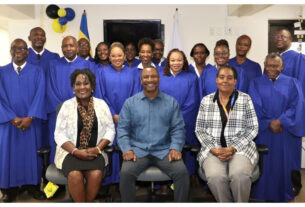PICTURED ABOVE Chief Education Officer, Dr. Ramona Archer-Bradshaw.
BY SHARON AUSTIN | FEB 15, 2022 | CORONA VIRUS, TOP STORIES
The Ministry of Education, Technological and Vocational Training has a draft roadmap for the safe, effective and efficient reopening of schools.
This disclosure came today from Chief Education Officer, Dr. Ramona Archer-Bradshaw, who said the objectives of the plan were to sensitise education partners about the requirements for the safe return to school, and identify the roles and responsibilities of key stakeholders, so as to ensure the safe operation of schools during the pandemic.
The roadmap, Dr. Archer-Bradshaw pointed out, had been shared on the Ministry’s Instagram and Facebook pages, and she encouraged members of the public to familiarise themselves with it.
She made the comments as she spoke during a press conference to discuss the resumption of face-to-face classes, which will begin for some students on Monday, February 21.
The Chief Education Officer explained that there were some main requirements for the safe reopening of schools, and she listed them as: all students in classrooms should be seated three feet apart; follow the COVID-19 protocols, and wear masks at all times.
“Of course, allowances will be made for mask breaks. Sanitising stations are also a requirement and this is across all levels, from nursery to secondary. We also want to conduct random testing for students and staff across nursery, primary and secondary schools.
“In the first phase … we identified the Nursery, Reception, Infants A and Infants B students…. Class four students [because] they need to be able to transition successfully to the secondary school. As a result, they need to experience as much face-to-face instruction as they can. They need to develop their social skills.“
Chief Education Officer, Dr. Ramona Archer-Bradshaw
“I must say at this time that the random testing will not occur during the first week or the second week. We are awaiting the swabs and as soon as we receive the swabs and training has taken place, the random testing will occur. For students, we require parental consent and the parental consent forms will be made available,” she stated.
Dr. Archer-Bradshaw disclosed that students would be returning to school in two phases. She noted that some of those in the first group were students who were unable to self-regulate and navigate devices on their own, and needed the support of adults in the online environment.
“In the first phase … we identified the Nursery, Reception, Infants A and Infants B students…. Class four students [because] they need to be able to transition successfully to the secondary school. As a result, they need to experience as much face-to-face instruction as they can. They need to develop their social skills.
“First formers [because] they too need the opportunity to experience the culture of their new secondary school…. Fourth, fifth and sixth formers, [as] there is a need for them to participate in practical activities, especially those who are pursuing examinations, and are required to submit their school based assessments,” she explained.

She stated that children with special needs would also be returning in the first phase as they needed that face-to-face interaction, in order to reach their cognitive and developmental milestones.
The Chief Education Officer added that those in the second phase would be Class 1, 2 and 3 children at the primary level, and Forms 2 and 3 at the secondary level. She pointed out, however, that the Ministry of Education would allow for flexibility to the phases, based on a few factors.
“We understand that there are some schools that are unable to have all of the students in the first phase at school in the first week. Where that is happening, we are recommending that the principals utilise a Group A and a Group B approach, which allows for children to have at least five days of face-to-face school within a two-week period.
“First formers [because] they too need the opportunity to experience the culture of their new secondary school…. Fourth, fifth and sixth formers, [as] there is a need for them to participate in practical activities, especially those who are pursuing examinations, and are required to submit their school based assessments.”
Chief Education Officer, Dr. Ramona Archer-Bradshaw
“[For example], A student in Group A may go to…face-to-face school for three days in the first week, and they may have online for the other two days in that first week. In the second week, that same student in Group A may have two days of face-to-face instruction and the other three days online. In essence, that amounts to five days in a two-week period,” Dr. Archer-Bradshaw explained.
She said the end of the school day would be 2:00 p.m. However, those schools which start earlier, such as St. Leonard’s Boys’ and The St Michael’s School, would be allowed to close a little earlier than 2:00 p.m.
She added that principals of those schools which wanted to continue teaching until 2:30 or 3:00 p.m. because of the educational needs of the students should communicate their plans to the parents and guardians.
The Chief Education Officer said everything has been done to make the environment safe for children. She urged parents to keep their children at home if they were unwell.
“Parents if we want to…keep schools safe, you have the responsibility of ensuring that your child does not become the agent in the school for transmission. It cannot work if we do not have your support,” she stressed.




